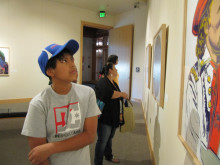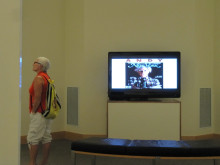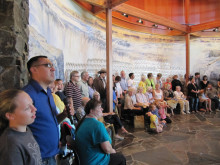OPB | Sept. 05, 2013
Contributed by April Baer
This month, a tribal museum in Pendleton is going Pop Art. Tamastslikt Cultural Institute is the place that celebrates Cayuse, Umatilla and Walla Walla tribal culture. But right now it’s exhibiting a series of Andy Warhol panels, in a collection entitled “Cowboys and Indians”. This is one of several events the museum planned to mark a milestone.
The ten panels and additional material are on loan to Tamastslikt from the Rockwell Museum in Corning, New York. Tamastslikt curator Randall Melton says the images are evenly divided among the Cowboys – iconic western figures like General Custer and John Wayne – and Indians – images Warhol obtained from what became the National Museum of the American Indian.
Melton explains, “People kind of give you the ‘Huh? How does that fit into a tribal interpretive center?’ “
He says this show is a departure from the museum’s usual cultural program, but an intentional one. The Tamastslikt show marks the first time these works have travelled. They’re typical of Warhol’s style – photographs, done up in silkscreen, then painted with lots of vibrant color.

“Zech” Cyr checks out an image of General Custer.
Dorothy Cyr a tribal member who works next door at the Wild Horse Casino, brought her 12 year old son Zech to see the show.
“It was nice,” the younger Cyr said, strolling amid the panels. “It was really odd the way he uses his art, how he made all the colors.”
Dorothy Cyr added, “I think it’s great opportunity for our tribe to have such works displayed on our reservation.”
The museum regularly pulls in visitors to the casino, but this exhibition, coinciding with Tamastslikt’s 15th anniversary, is intended in part to draw people coming to town for the Pendleton Roundup later this month, and anyone who may not have had the chance to see Warhol’s works before.
Pendleton resident Sue Petersen, who attended the opening, said she just missed a Warhol exhibition in San Francisco some years ago and was glad to see these works in town.
“I think this is just totally awesome,” Petersen said. “I’m blown kind of out of the park, I gotta see the rest of them.”

Sue Petersen of Pendleton was among those who came early on opening night to check out the exhibition.
Warhol had suffered some health problems by the time these works were completed in 1986. He’d survived a gunshot wound, and worked with a lot of assistants. Some critics believe his later works lack some of the snap and wit of earlier pieces.
After seeing the panels, Jubertino Arranda, a young artist, said he shares some of those reservations.
“I personally do like a lot of earlier work,” Arranda said. “For me, it was very hit and miss after his brush with death.”
But Arranda still drove all the way from Walla Walla to see the show opening, and loved the technique, and Warhol’s elevation of everyday objects in some of the images. Speaking excitedly about seeing the works in person, Arranda broke off, saying, “Oh, gosh, he was so smart, I think he was really ahead of his time.”
Loretta Alexander is a retired painter herself, a Cayuse tribal member, and the mother of painter Philip Minthorne, whose has a vivid canvas hanging in an adjacent gallery room. She nods in approval at the Warhols’ temporary gallery.
“I liked it,” she said. “And the woman and the baby is the one I liked the best.”
That image, of an unidentified tribal woman with an infant on her back, is one of the few in the exhibition featuring an actual Native American person, notes Curator Randall Melton. Cowboys are represented with figures from Annie Oakley to Teddy Roosevelt. But, in choosing his tribal subjects, Warhol often opted for images like shield designs or an Indian head nickel. Melton wonders if the choice might have been intentional.

Curator Randall Melton (second from left) and others pose for a group photo as well-wishers mark Tamastslikt’s 15th birthday.
“It’s interesting to me that he chose these people versus these objects,” Melton said. “I was talking with someone who said that’s how Indian people were seen, things to be moved out of the way for Westward expansion.”
Melton says a lot of people expressed surprise that a tribal museum might consider including a group of images with stereotypical imagery – sometimes painful imagery -for native people. He points to a panel featuring an iconic photo of Geronimo staring directly into the camera.
Melton says the photo was taken after the Apache leader was forced to surrender to the U.S. Army. But Melton says gallery viewers are invited to draw their own conclusions about Warhol’s treatment of the image, and consider what the artist was trying to say.
“The reasoning why he put these images together the way he did,” Melton said, “it’s a statement on the idea of the old west, how thats more myth than fact.”
Also, Tamastslikt’s Executive Director Bobbie Conner points out shows like this, open to interpretation, also present the museum another chance to do its job.
“One of the goals of the project,”Conner explains, “is to break down stereotypes, and to replace those stereotypes with new information.”
Tamastslikt’s regular exhibitions are geared toward cultural and historical exhibitions about tribes represented in the region.
Conner says the museum is doing pretty well, with over 600,000 visitors to the building. After 15 years, the museum is still paying down some of the debt associated with its construction. Conner says she takes deep pleasure seeing the direct access to history the museum unlocks for tribal members and others. Young people trained as teenaged tours guides when the museum opened now have young families of their own, and are bringing their own kids to shows like the Warhol exhibition.
Conner remembers riding horseback as a child in the field where the museum now stands, at the base of rolling hills, next to the tribe’s busy Wild Horse casino.
“Of all the things you could grow up to be,” she recalls, “this was never in my mind’s eye. Our tribe is less than three-thousand members, for us to have this 80 million resort here, including the museum is 180 degrees from when I was a child here. I’m still sometimes surprised I get to work here.”
Tamastslikt will keep Warhol’s Cowboys and Indians on display through October 26th.
